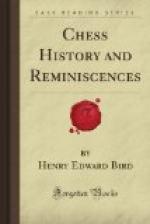Whatever difference of opinion may exist as to the exact spot from whence chess first sprung, its Asiatic origin is undoubted. The elephant, ship, or boat in the game was illustrative of its mode of warfare. The identity of the pieces in the ancient game with ours of the present day affords striking confirmation of it, whilst the most competent and esteemed authorities who have devoted the greatest attention and research to the subject deem the evidence of language conclusive proof that the Persian Chatrang, which we first hear of under date of about 540 A.D., was derived from the ancient Hindu Chaturanga, found described in original Sanskrit records.
It is generally assumed on very fair inferences that the Arabians were expert chess players, and also excelled in blindfold play. The game was known among them in the days of the prophet, 590 to 632, who finding some engaged at chess asked them, “What images are these which you are so intent upon?” For they seemed to have been new to him, the game having been very lately introduced into Arabia from Persia. Nice gradations of skill were observed among them, and thirteen degrees of odds are enumerated among them down to the rook. To give any odds beyond the rook, says one of the manuscripts, can apply only to women, children, and tyros. For instance, a man to whom even a first-class player can afford to give the odds of a rook and a knight has no claim to be ranked among chess players. In fact the two rooks in chess are like the two hands in the human body, and the two knights are, as it were, the feet. Now that man has very little to boast of on the score of manhood and valour who tells you that he has given a sound thrashing to another man who had only one hand and one foot. It may be observed, however, that proportionately to the value of all the pieces in the old game, as compared with the present, the rook and knight would be equivalent to queen and rook with us.
The earliest Greek reference brought to notice is in a laconic correspondence between the Emperor Nicephorus of Constantinople, successor to the Princess Irene, and the famous Harun Ar Rashid of Bagdad, the fifth of the Abbasside dynasty, in 802, which mentions Pawn and Rook, implying that his predecessor in paying tribute resembled rather the former for weakness than the latter for strength; but it had probably been known among the Greeks before the death of Justinian, in 565, as he was contemporary with Chosroes, and these rulers were at peace and in friendly terms of communication, allowing interpretations of their respective records, which seem to have been of mutual interest.
All the writers who assert that the ancient Greeks and Romans were unacquainted with chess have overlooked the Roman edict of 115 B.C., in which both chess and Draughts were specially exempted from prohibition.




